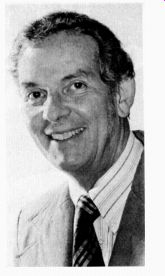The Men Who Made an Industry
Fourteenth in a series
by Norman Eisenberg

To MOST PEOPLE who know something of the history of the audio industry, the name of Ed Miller is associated with Sherwood Electronic Laboratories, Inc., which he helped to found in 1955. But Miller had already made his mark nine years earlier, at the age of twenty-five, at Radio Craftsmen--a manufacturer of truly classic components, though the name is virtually unknown to current audiophiles of less than middle age. It was there that he solved the "drift problem" then plaguing FM tuners by introducing an automatic frequency control into the circuit. The basic idea behind AFC was already in the engineering text books, but he was the first to incorporate it into an FM tuner.
Born in Cincinnati, Miller earned a degree in electrical engineering at the University of Cincinnati in 1943. Even as a student, he was a radio hobbyist with a penchant for FM. He held various jobs, including some time with Stewart-Warner, a stint as laboratory engineer with Naval Ordnance, and a period in the research labs of General Electric, before he joined Radio Craftsmen in Chicago in 1945. As he rose to vice president and director of engineering, he was largely responsible for that company's entry into the manufacture of high fidelity tuners and amplifiers, and by the mid-1950s it was among the largest producers of FM tuners. But it was apparent that the distribution setup was ailing. A brief attempt to bypass retail dealer outlets and sell by mail order was un successful, and Radio Craftsmen folded.
Miller then joined forces with Emil Plank, John Snow, and John Clark of Elrad, a radio coil manufacturer. They started Sherwood-named after the Chicago suburb of Sherwood Forest where Miller lived--as a subsidiary of Elrad. (Today Sherwood is the owner of Elrad.) Snow and Clark have continued in administrative posts; Plank, who served as production chief, died in 1967. Miller, as vice president and general manager, proceeded to direct the engineering and production of a long succession of tuners, amplifiers, and receivers that quickly gained a reputation as being among the best available. Providing the best possible value to the music-lover, rather than the best attainable performance in absolute terms, was the philosophy be hind this reputation.
The distinctive styling of the products was among Miller's contributions. At a time when most audio components still looked as if they belonged more properly in a studio than in a living room, Sherwood began using a low-profile design with startling white front panels that framed colorful controls and tuning dials. The components also came "pre-wrapped" in finished cases (no tubes or transformers were visible) that could be set right on a shelf or cabinet top. Some models eventually were offered with color options so they could be tailored to room decor.
This emphasis on decorative appeal was complemented by controls that avoided unnecessary technician-oriented complications found on many competing designs.
In 1970, Miller left Sherwood, partly because of a yearning for a change of scenery: He and his wife, Nan, decided they wanted to live in California. Another reason was a disagreement with Sherwood stockholders over their intention to move manufacturing facilities to the Orient.
The two forces coalesced into a decision when Miller was approached by Morris Kessler, president of a small company in Los Angeles known as SAE (Scientific Audio Electronics, though the full name is seldom used), whose ten employees produced a line of amplifiers, preamps, and equalizers. Miller designed its FM equipment and a digital tuner, and soon be came head of the SAE engineering department.
He left for a year to become engineering manager of Acoustical Control, reportedly the third largest manufacturer of public-address and music-performing amplifiers in the U.S. But the seeds planted at SAE bore fruit; the company grew, and he was asked to return in 1973. For a time he worked with a young engineer named James Bongiorno, who had replaced Miller during the year-long break from SAE and who designed its present line of amplifiers. They were a formidable team of technical talent.
In late 1974, Bongiorno decided to go out on his own. The first product of his Great American Sound Company (he has neither confirmed nor denied that he chose the name for its acronym GAS) was a kit for building a high-powered amplifier. A year later, he succeeded in persuading his old working partner to join him at GAS. There was a brief period when Miller worked for both companies at the same time, which probably is some thing of an innovation in a highly competitive industry and also per haps indicative of a new spirit of technical fraternity abroad in the audio field in recent years.
GAS has since ceased to make kits and is now making fully assembled preamps and power amps, of which the Ampzilla (definitely intentional humor) is probably the best known.
Miller reports that the company, of which he now is part owner, "is growing like wildfire" and may produce a tuner in the foreseeable future.
Tall, lean, and athletic at fifty-five, Miller retains all the enthusiasm for high fidelity sound that drove him in his salad days. His sole hobby is botany, and the results of his work in this area enhance his reputation as a man with an exceptional ability to make things grow.
-------------
(High Fidelity, Feb 1977)
Also see:
Hi-Fi Pathfinders--DAVID HAFLER
High Fidelity Pathfinders--The Men Who Made an Industry (Apr. 1977)